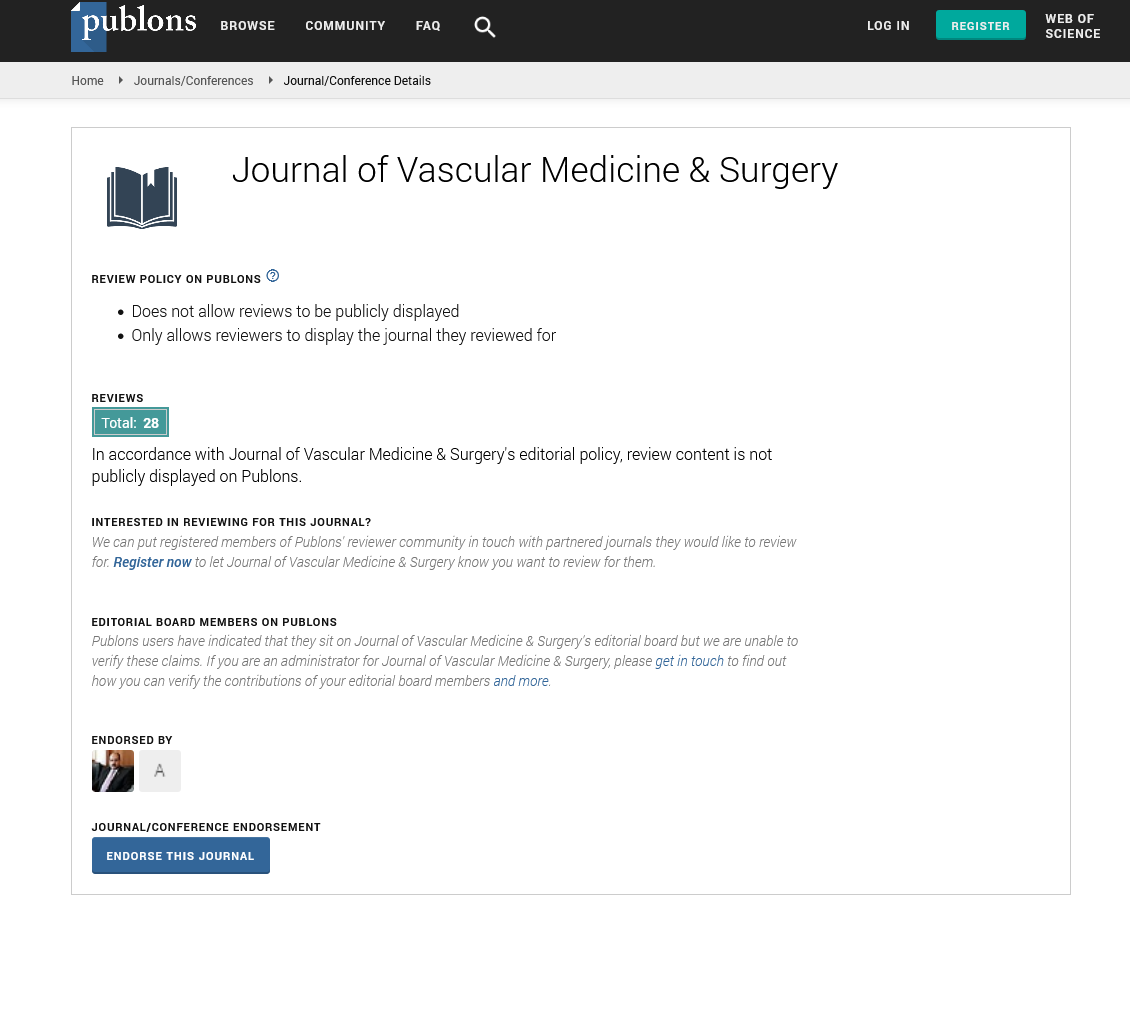Indexed In
- Open J Gate
- Academic Keys
- RefSeek
- Hamdard University
- EBSCO A-Z
- OCLC- WorldCat
- Publons
- Euro Pub
- Google Scholar
- SHERPA ROMEO
Useful Links
Share This Page
Journal Flyer

Open Access Journals
- Agri and Aquaculture
- Biochemistry
- Bioinformatics & Systems Biology
- Business & Management
- Chemistry
- Clinical Sciences
- Engineering
- Food & Nutrition
- General Science
- Genetics & Molecular Biology
- Immunology & Microbiology
- Medical Sciences
- Neuroscience & Psychology
- Nursing & Health Care
- Pharmaceutical Sciences
Opinion Article - (2024) Volume 12, Issue 6
Clinical Developments in Early Detection and Treatment for Unicuspid Aortic Valve
Rolando Franco*Received: 28-Oct-2024, Manuscript No. JVMS-24-27811; Editor assigned: 30-Oct-2024, Pre QC No. JVMS-24-27811 (PQ); Reviewed: 13-Nov-2024, QC No. JVMS-24-27811; Revised: 20-Nov-2024, Manuscript No. JVMS-24-27811 (R); Published: 27-Nov-2024, DOI: 10.35248/2329-6925.24.12.574
Description
A rare congenital heart condition known as Unicuspid Aortic Valve (UAV) is defined by the aortic valve's isolated functioning point. The UAV causes major anatomical and functional defects that frequently lead to aortic stenosis, aortic regurgitation, or a combination of both, in comparison with the more prevalent tricuspid aortic valve. Due to the early start of valve disease, this abnormality usually appears in young people and affects about 0.02% of the general population. The fourth to seventh week of pregnancy is when the aortic valve starts to form. It originates from the conotruncal ridges and endocardial cushions, which aid in the development of the pulmonary and aortic valves. A UAV is produced when the typical point development fails. The valve develops as a single crescent-shaped or circular structure rather than three separate points. There are two main morphologic subtypes of UAVs that have been identified: Commissural UAVs contain a single commissure, which gives them an eccentric or slit-like aperture, and Acommissural UAVs do not have commissures and usually have a round or oval opening. Both varieties put the valve at risk for severe hemodynamic stress, which eventually results in calcification, progressive fibrosis, and malfunction. Because of its aberrant structure, the UAV experiences turbulent blood flow and significant shear stress, this increases the degeneration of its valves.
Retrograde blood flow into the left ventricle during diastole is caused by incomplete valve closure brought on by structural abnormalities. Complications include heart failure, decreased cardiac output, and left ventricular dilatation can result from the hemodynamic load these disorders place on the body. The severity of valve dysfunction and the patient's age affect UAV symptoms. Many people don't have any symptoms while they are kids or teenagers. Particularly in young players with untreated significant aortic stenosis, UAV can cause serious cases of heart failure or sudden cardiac death. To avoid difficulties, it is essential to diagnose UAVs early and accurately. Usually, a mix of sophisticated imaging methods and clinical assessment is used. The primary diagnostic method is Transthoracic Echocardiography (TTE). It evaluates left ventricular function, visualizes the valve morphology, and quantifies the degree of leakage or stenosis.
The degree of valve malfunction, related multiple medical conditions, and symptom severity all influence how UAV is managed. Medical management, surgery, or transcatheter procedures are among the available treatment options. Betablockers and diuretics can be used to treat the symptoms of heart failure. However, the main cause of valve disease is not addressed by these short-term fixes. The only effective therapy for UAVs is surgery. Patients with symptoms, progressive left ventricular failure, and severe aortic stenosis or regurgitation are among the indications. For high-risk surgical candidates, TAVR has become a competitive option in recent years. However, because of anatomical differences and the requirement for specialized valve designs, its use in UAV patients is still difficult. First described by Edwards in 1958, the unicuspid aortic valve is an incredibly uncommon congenital abnormality. It has been calculated that the adult population has a 0.02% annual incidence of UAV.
The normal three leaflets begin to form but eventually fuse together rather than remaining apart in cases with unicuspid aortic valve disease. This takes place before to delivery. According to a study, 97% of patients with unicuspid aortic valves who underwent aortic valve surgery survived for ten years. Getting a new prosthetic aortic valve could significantly shorten the life expectancy of individuals under 65 who have a unicuspid aortic valve by more than ten years. For this reason, researchers recommend the Ross method for individuals who are active and young. By using the Ross method, a medical professional replaces their damaged aortic valve with a personalized pulmonary valve. A pulmonary homograft, or valve from a donated human heart, is then inserted into the original pulmonary valve position.
Progressive valve malfunction and related consequences are features of UAV's natural history. Serious morbidity and mortality may result from severe aortic stenosis or regurgitation if treatment is not received. However, the outcome is greatly improved with prompt transcatheter or surgical procedures. A strong index of suspicion is necessary for the early diagnosis and treatment of unicuspid aortic valve, a rare but clinically severe congenital abnormality. Advances in imaging techniques and surgical procedures have substantially altered results for affected patients. The management of this difficult condition may be improved by ongoing research on specific transcatheter devices and valve repair methods.
Citation: Franco R (2024). Clinical Developments in Early Detection and Treatment for Unicuspid Aortic Valve. J Vasc Surg. 12:574.
Copyright: © 2024 Franco R. This is an open-access article distributed under the terms of the Creative Commons Attribution License, which permits unrestricted use, distribution, and reproduction in any medium, provided the original author and source are credited.

